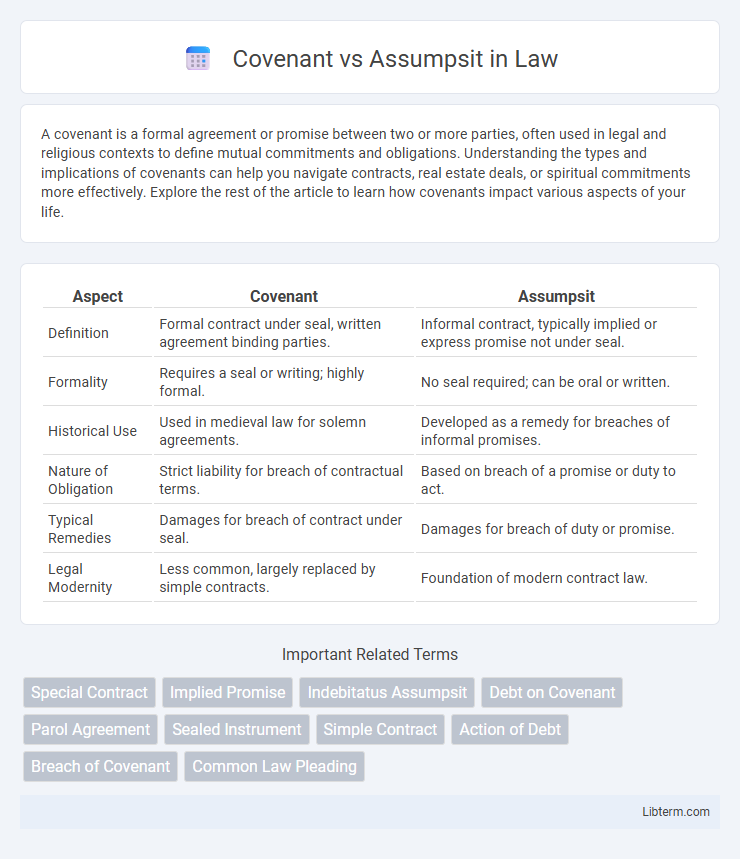A covenant is a formal agreement or promise between two or more parties, often used in legal and religious contexts to define mutual commitments and obligations. Understanding the types and implications of covenants can help you navigate contracts, real estate deals, or spiritual commitments more effectively. Explore the rest of the article to learn how covenants impact various aspects of your life.
Table of Comparison
| Aspect | Covenant | Assumpsit |
|---|---|---|
| Definition | Formal contract under seal, written agreement binding parties. | Informal contract, typically implied or express promise not under seal. |
| Formality | Requires a seal or writing; highly formal. | No seal required; can be oral or written. |
| Historical Use | Used in medieval law for solemn agreements. | Developed as a remedy for breaches of informal promises. |
| Nature of Obligation | Strict liability for breach of contractual terms. | Based on breach of a promise or duty to act. |
| Typical Remedies | Damages for breach of contract under seal. | Damages for breach of duty or promise. |
| Legal Modernity | Less common, largely replaced by simple contracts. | Foundation of modern contract law. |
Introduction to Covenant and Assumpsit
Covenant and Assumpsit are foundational concepts in common law contract remedies, with covenant referring to a formal, written agreement enforcing specific promises between parties. Assumpsit evolved as a more flexible, implied contract action allowing recovery for non-performance of agreements not under seal. These legal doctrines establish the basis for enforcing contractual obligations and differentiating between sealed and informal contracts.
Historical Origins of Covenant
Covenant originated in medieval English law as a formal written agreement sealed by the parties to guarantee performance, distinguishing it from oral promises. Its historical roots trace back to feudal society where land transactions and obligations required solemnity and clear evidence through sealed documents. The strict formalism and reliance on seals made covenant a distinct and enforceable contract form before assumpsit developed as a remedy for less formal promises.
Historical Development of Assumpsit
Assumpsit emerged in medieval English common law as a remedy to expand contract enforcement beyond the rigid forms of covenant, initially dealing with nonfeasance rather than misfeasance. The development of assumpsit allowed plaintiffs to claim damages for breaches of informal promises, reflecting evolving commercial practices and increasing reliance on flexible contractual obligations. By the 16th century, assumpsit had become a dominant cause of action, transforming contract law by enabling courts to enforce a broader range of agreements without the need for formal seals.
Key Legal Definitions: Covenant vs Assumpsit
Covenant is a formal, written promise or agreement between parties, typically involving a specific obligation enforceable by law, often found in property and contract law. Assumpsit is a legal action based on an implied or express promise, focusing on the recovery of damages for breach of a contract or agreement not under seal. The key distinction lies in covenant requiring a sealed document and strict performance, while assumpsit allows recovery based on breach of agreement without a seal, emphasizing damages for nonperformance.
Essential Elements of a Covenant
A covenant is a formal, written agreement that requires clear identification of parties, precise terms, and a lawful object, distinguishing it from assumpsit, which involves implied or informal promises. Essential elements of a covenant include mutual consent, consideration, and the intention to create legal relations, ensuring enforceability under contract law. Unlike assumpsit, covenants demand strict compliance with agreed terms, often used in property and commercial contexts.
Essential Elements of Assumpsit
Assumpsit requires a clear promise, either express or implied, that creates a duty enforceable by law, emphasizing mutual agreement and consideration. The essential elements include a valid contract, a breach of that contract, and resulting damages from the breach. Unlike covenant, assumpsit focuses on the liability arising from failing to fulfill an obligation rather than a sealed agreement.
Differences in Legal Remedies
Covenant primarily allows for monetary damages as a remedy for breach of contract, focusing on compensation for losses directly resulting from the failure to perform a formal written agreement. Assumpsit offers broader relief options, including restitution and specific performance, addressing breaches of informal or implied contracts where the party seeks to recover value or enforce obligations. The key difference lies in covenant's strict application to express contracts with formal execution, whereas assumpsit applies to implied contracts and equitable remedies.
When to Use Covenant or Assumpsit
Covenant is used when a contract includes a specific promise or agreement under seal, typically requiring formal written documentation to be enforceable. Assumpsit applies to informal agreements or promises not under seal, allowing for recovery in cases of breach of contract based on the implied or express promise. Choosing between covenant and assumpsit depends on whether the obligation is under seal or arises from a simple contract, affecting the statute of limitations and proof requirements.
Notable Case Law Examples
In landmark cases such as *Hawkins v. Fewings* (1988) and *Carr v. Jaques* (1932), courts distinguished covenant from assumpsit by examining the formality and express promises within contracts. *Hawkins v. Fewings* clarified that covenant requires a sealed document or formal written agreement, whereas assumpsit applies to implied or informal contracts based on conduct. The ruling in *Carr v. Jaques* reinforced that assumpsit addresses breaches of contract where no formal seal exists, emphasizing the significance of express or implied promises over strict contractual formalities.
Conclusion: Covenant vs Assumpsit in Modern Law
Modern law largely favors assumpsit over covenant due to its flexibility in addressing breaches of contract without formal seals or specialized language. Assumpsit allows courts to enforce promises based on implied or express agreements, streamlining dispute resolution and expanding contractual protections. Covenant remains relevant mainly in specific formal agreements, but its strict requirements limit widespread application compared to the adaptable nature of assumpsit.
Covenant Infographic

 libterm.com
libterm.com